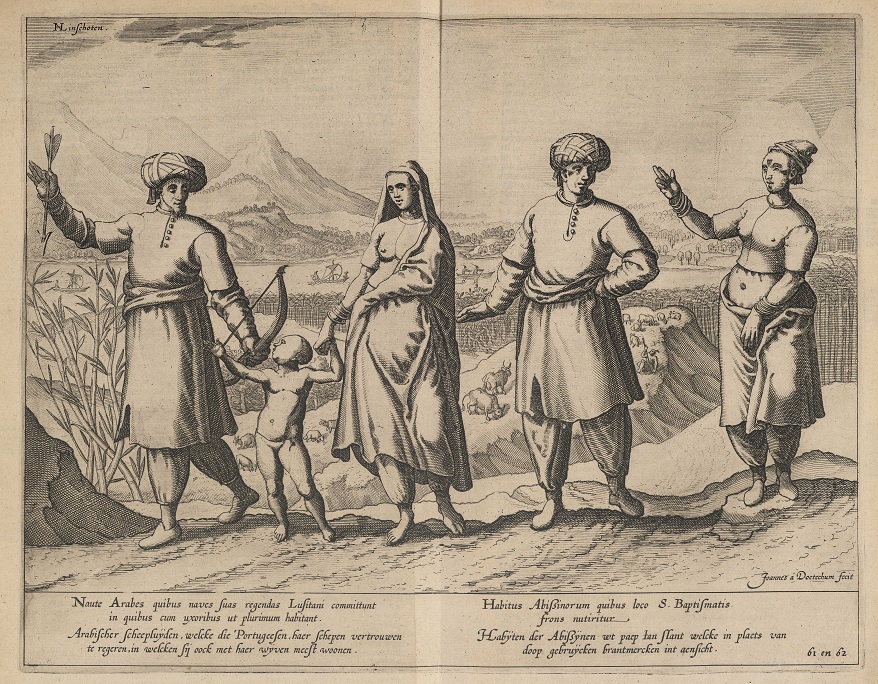Arabian Peninsula
Timo Middelbos
This contribution is published in both Dutch and English. You will find the English version below.
| Nummer Koeman’s Atlantes Neerlandici, vol. II | 8180:2 |
| Titel kaart / Titel tekst | ARABIA / Arabien |
‘Het is byna vierkant, en is meer dan een Half-eylant; want de zee bespoelt het aen drie sijden.’ Aldus de geografische omschrijving van het Arabisch schiereiland in de Grooten Atlas. In de zeventiende eeuw onderscheidde men drie gedeelten: Arabie Petrea, ’t Geluckige Arabie en ’t Woeste Arabie.
Het Gelukkige Arabië stond bekend om zijn rijkdom, handel en vruchtbaarheid. De Arabieren die aan de kust wonen, worden door Blaeu beschreven als van een ‘schoonder gestalte, en veel aangenamer dan d’ andere Arabiers.’ Daarnaast beweert Blaeu dat de kustbewoners een goed verstand hebben, voortreffelijk spreken en zich bezighouden met poëzie en de geneeskunde. Hieruit blijkt een zekere mate van respect en bewondering voor de culturele en intellectuele ontwikkelingen van het Gelukkige Arabië. Van respect of bewondering is echter geen sprake meer als we de passages over de andere gebieden doornemen. Zo blijkt Blaeu de bevolking van Arabië consistent denigrerend te beschrijven. Hij vermeldt dat de Arabieren in het algemeen ‘leelijck, mager, droogh en bruyn, als door de hitte gebrant’ zijn. Verder: ‘sy hebben een vrouwelijcke stem, en swarte oogen, met een fel en wreet gelaet.’

Jan Huygen van Linschoten, Itinerarivm, ofte schipvaert naer Oost ofte Portugaels Indien (Amsterdam: Jan Evertsz Cloppenburch, 1614), p. 62/63
Het is natuurlijk interessant om te onderzoeken waar deze negatieve associaties vandaan komen. Daar zijn verschillende redenen voor te noemen. Enerzijds is er sprake van een nomadische cultuur die sterk afwijkt van de Europeanen die sedentair leven. Ook de kleding (‘schamel’) en de Arabische handelswijze (‘roofachtig’) werden veroordelend beschreven. Maar het is vooral in de religie dat het Arabische volk negatief wordt geassocieerd in de atlas van Blaeu. Die associatie gaat terug tot de Middeleeuwen, waarin de islam ontstaat en al snel in botsing komt met het christendom. Aanvankelijk in het Nabije Oosten, maar in de achtste en negende eeuw ook op het Iberisch schiereiland en zelfs tot in Frankrijk. In de tijd van Blaeu was het vooral de dreiging van de Ottomanen, in Centraal-Europa en op de Middellandse Zee, die bijdroeg aan een negatief beeld van het islamitisch geloof en iedereen die het beleed.
Zo kan deze schijnbaar ambivalente houding van Blaeu – het tegelijkertijd voorkomen van bewondering en afkeer – in zijn beschrijving van de Arabieren verklaard worden.
Suggestie om verder te lezen:
Varthema, L. de, Jones, J. W., Badger, G.P. (1970). The travels of Ludovico di Varthema in Egypt, Syria, Arabia Deserta and Arabia Felix, in Persia, India and Ethiopia, a.d. 1503 to 1508 (Reproduction of the Works issued by the Hakluyt Society, 32). New York: Franklin.
| Koeman’s Atlantes Neerlandici, vol. II | 8180:2 |
| Title map / Title text | ARABIA / Arabien |
‘Het is byna vierkant, en is meer dan een Half-eylant; want de zee bespoelt het aen drie sijden’ [It is almost square and more than a peninsula; because it has a sea on three sides]. This is how Blaeu describes the geography of the Arabian Peninsula in his Atlas Maior. Arabia was divided into three parts in the seventeenth century: Arabia Petrea (rocky), Arabia Felix (fortunate), and Arabia Deserta (empty).
Fortunate Arabia was known for its riches, trade, and fertile land. Blaeu describes the coastal Arabs as ‘van schoonder gestalte, en veel aangenamer dan d’ andere Arabiers’ [better looking and much more pleasant than the other Arabs]. Blaeu also claims that the coastal dwellers were intelligent, eloquent, and adept at poetry and medicine. This shows a certain level of respect and admiration for the cultural and intellectual developments in Fortunate Arabia. That said, there is a complete lack of respect or admiration in Blaeu’s description of the other regions. Blaeu consistently uses derogatory terms to describe the Arabian population, calling them ‘leelijck, mager, droogh en bruyn, als door de hitte gebrant’ [ugly, skinny, dry, and having brown skin as if burnt by the heat]. He also says that ‘sy hebben een vrouwelijcke stem, en swarte oogen, met een fel en wreet gelaet’ [they have a feminine voice and black eyes in fierce and cruel faces].
What would be the reason for these negative descriptors? A few reasons come to mind. First of all, the Arabs were nomadic people, a very different lifestyle from the Europeans’ sedentary lives. Their clothes (‘schamel’ [shabby]) and the Arabian trading practices (‘roofachtig’ [extortionate]) were also described dismissively. But, first and foremost, it is because of their religion that the Arab peoples are criticized in Blaeu’s Atlas. This sentiment dates back to the Middle Ages when Islam originated and came into conflict with Christianity soon after, initially in the Near East, but – in the eighth and ninth centuries – also on the Iberian Peninsula and as far north as France. In Blaeu’s time, it was mostly the threat of the Ottomans, in Central Europe and the Mediterranean, that contributed to the negative view toward Islam and Muslims.
This explains Blaeu’s seemingly ambivalent opinion, i.e. both admiration and dislike, in his description of the people of Arabia.
Further reading:
Varthema, L. de, Jones, J. W., Badger, G.P. (1970). The travels of Ludovico di Varthema in Egypt, Syria, Arabia Deserta and Arabia Felix, in Persia, India and Ethiopia, a.d. 1503 to 1508 (Reproduction of the Works issued by the Hakluyt Society, 32). New York: Franklin.
